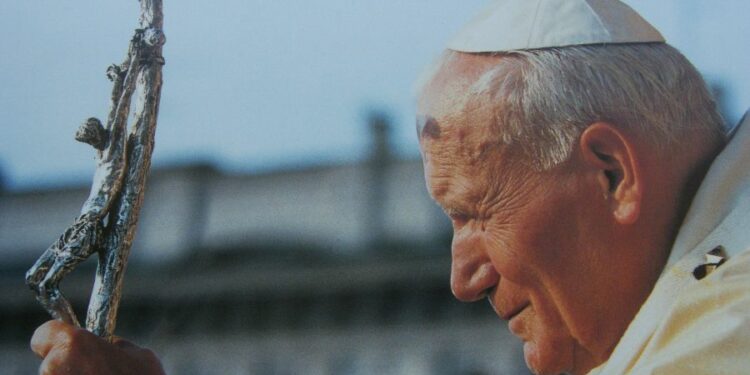“It is truly marvelous how her devotion to the merciful Jesus is spreading in our contemporary world and gaining so many human hearts! This is doubtlessly a sign of the times — a sign of our 20th century. The balance of this century, which is now ending, in addition to the advances which have often surpassed those of preceding eras, presents a deep restlessness and fear of the future. Where, if not in the divine mercy, can the world find refuge and the light of hope? Believers understand that perfectly.”
6. Seven years later on another Divine Mercy Sunday, April 30, 2000, the first of the new millennium, John Paul II canonized Sister Faustina, “the great apostle of Divine Mercy.” The pope said:
“Divine mercy reaches human beings through the heart of Christ crucified: ‘My daughter, say that I am love and mercy personified,’ Jesus will ask Sister Faustina (‘Diary,’ 1074). Christ pours out this mercy on humanity though the sending of the Spirit who … is love. And is not mercy love’s ‘second name’ (Dives in Misericordia, 7), understood in its deepest and most tender aspect, in its ability to take upon itself the burden of any need and, especially, in its immense capacity for forgiveness?”
7. That day John Paul II also added:
“What will man‘s future on earth be like? We are not given to know … But the light of divine mercy, which the Lord in a way wished to return to the world through Sister Faustina’s charism, will illuminate the way for the men and women of the third millennium.”
8. That same day, John Paul II gave many memorable insights into and words about divine mercy:
“This consoling message is addressed above all to those who, afflicted by a particularly harsh trial or crushed by the weight of the sins they committed, have lost all confidence in life and are tempted to give in to despair. To them the gentle face of Christ is offered; those rays from his heart touch them and shine upon them, warm them, show them the way and fill them with hope. How many souls have been consoled by the prayer ‘Jesus, I trust in you,’ which Providence intimated through Sister Faustina! This simple act of abandonment to Jesus dispels the thickest clouds and lets a ray of light penetrate every life. ‘Jezu, ufam tobie.’”
9. In his Divine Mercy Sunday homily in 2001, it was obvious the Holy Father was describing the meaning of the image of the divine mercy when he said:
“The heart of Christ! His ‘Sacred Heart’ has given men everything: redemption, salvation, sanctification. St. Faustina Kowalska saw coming from this heart that was overflowing with generous love two rays of light, which illuminated the world. ‘The two rays,’ according to what Jesus himself told her, ‘represent the blood and the water’ (‘Diary,’ p. 132). The blood recalls the sacrifice of Golgotha and the mystery of the Eucharist; the water, according to the rich symbolism of the evangelist John, makes us think of baptism and the gift of the Holy Spirit (Jn 3:5; 4:14).
“Through the mystery of this wounded heart, the restorative tide of God’s merciful love continues to spread over the men and women of our time. Here alone can those who long for true and lasting happiness find its secret.”
10. At the same time, John Paul II reminded us of something Christ in his divine mercy messages said we must do:
(Story continues below)
Subscribe to our daily newsletter
“Christ has taught us that ‘man not only receives and experiences the mercy of God, but is also called’ to practice mercy toward others: ‘Blessed are the merciful, for they shall obtain mercy’ (Mt 5:7). He also showed us the many paths of mercy, which not only forgives sins but reaches out to all human needs. Jesus bent over every kind of human poverty, material and spiritual.”
11. In Dives in Misericordia, written in 1980, three years after being elected pope, John Paul II focused on God’s mercy especially shown through Jesus Christ, writing:
“Christ confers on the whole of the Old Testament tradition about God’s mercy a definitive meaning. Not only does he speak of it and explain it by the use of comparisons and parables, but above all he himself makes it incarnate and personifies it. He himself, in a certain sense, is mercy. To the person who sees it in him — and finds it in him — God becomes ‘visible’ in a particular way as the Father who is rich in mercy.”
12. The pope also wrote:
“The truth, revealed in Christ, about God the ‘Father of mercies,’ enables us to ‘see’ him as particularly close to man especially when man is suffering, when he is under threat at the very heart of his existence and dignity. And this is why, in the situation of the Church and the world today, many individuals and groups guided by a lively sense of faith are turning, I would say almost spontaneously, to the mercy of God. They are certainly being moved to do this by Christ himself, who through his Spirit works within human hearts.”
13. A very Marian pope, John Paul II wrote this about our Blessed Mother’s role in divine mercy:
Credit: Source link




